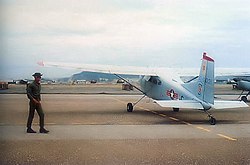| Cessna 185 Skywagon | |
|---|---|
 A Cessna 185 with floats | |
| General information | |
| Type | Light utility aircraft |
| Manufacturer | Cessna Aircraft Company |
| Status | Active |
| Number built | 3,916 [1] |
| History | |
| Manufactured | 1961–1985 |
| Introduction date | 1961 |
| First flight | July 1960 |
| Developed from | Cessna 180 |
| Variant | St-Just Super-Cyclone |
The Cessna 185 Skywagon is a six-seat, single-engined, general aviation light aircraft manufactured by Cessna. It first flew as a prototype in July 1960, with the first production model completed in March 1961. The Cessna 185 is a high-winged aircraft with non-retractable conventional landing gear and a tailwheel.
Contents
- Design and development
- Operational history
- Variants
- Civil variants
- Military variants
- Operators
- Civil operators
- Military operators
- Accidents and incidents
- Specifications (1978 Cessna 185 II landplane)
- Specification for differing configurations
- See also
- Notes
- References
- External links
Over 4,400 were built with production ceasing in 1985. When Cessna re-introduced some of its most popular models in the 1990s, the tailwheel equipped Cessna 180 and 185 were not put back into production.


